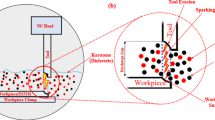Abstract
In this work, an improved weld-bead geometry and reduced sheet metal distortion were desired in a weld-brazing process used to finish exterior sheet metal prior to painting. Numerical modeling techniques are widely used to model welding processes, but accurate methods for modeling pulsed-welding processes are lacking. Instead, a continuous empirical model of the welding process was developed using a statistically designed experiment and a neural network for data analysis. Graphical methods were used to simulate the process, and robust parameter design techniques were used to analyze response surfaces produced by the model. Using the response surfaces, possible welding procedures were generated and tested. A new process that resulted in improved joint quality was implemented in production.
Similar content being viewed by others
References
D. Rosenthal, “The Theory of Moving Sources of Heat and Its Application to Metal Trementas,”Trans. ASME, 68 (1946), pp. 849–866.
J. Mazumder, “Finite Element Modeling of Heat Transfer for GTA Welding,”Met. Con., 10 (1987), pp. 599r-606r.
J.-W. Kim and S.-J. Na, “A Study on the Effect of Contact Tube-to-Workpiece, Distance on Weld Pool Shape in GMA Welding,”Weld. J., 5 (1995), pp. 141s-152s.
R.T.C. Choo, J. Szekely, and R.C. Westhoff, “On the Calculation of the Free Surface Temperature of GTA Weld Pools from First Principles: Part I. Modeling the Welding Arc,”Met. Trans. B., 23B (1992), pp. 357–369.
R.T.C. Choo, J. Szekely, and S.A. David, “On the Calculation of the Free Suface Temperature of GTA Weld Pools from First Principles: Part II. Modeling the Weld Pool and Comparison with Experiments,”Met. Trans. B., 23B (1992), pp. 371–384.
R.T.C. Choo and J. Szekely, “Vaporization Kinetics and Surface Temperature in a Mutually Coupled Spot GTA Weld and Weld Pool,”Weld. J., 3 (1992), pp. 77s-93s.
J.K. Hong and C.L. Tsai, “Finite Element Simulation of Residual Stresses in Multi-pass Welds,”Proc Int'l Conf on Modeling and Control of Joining Processes (Miami, FL: AWS, 1994), pp. 470–476.
R.G. Thompson and Y. Liu, “Monte Carlo Simulation of HAZ Grain Growth”,Proc. Int'l Conf. on Modeling and Control of Joining Processes, (Miami, FL: AWS, 1994), pp. 314–320.
P. Tekriwal and J. Mazumder, “Transient and Residual Thermal Strain-Stress Analysis of GMAW”,Trans. ASME, 7 (1991), pp. 336–343.
J. Goldak, M. Gu and L. Karlsson, “Numerical Aspects of Modeling Welds,”ASM Handbook, 6 (1993) pp. 1131–1140.
M. Gu, J. Goldak, and E. Hughes, “Steady State Thermal Analysis of Welds with Filler Metal Addition,”Canadian Metallurgical Quarterly, 32 (1) (1993) pp. 49–55.
L. Quintino and C.J. Allum, “Pulsed GMAW: Interactions Between Process Parameters—Part 1”,Welding and Metal Fabrication, 3 (1984), pp. 85–89.
L. Quintino and C.J. Allum, “Pulsed GMAW: Interactions Between Process Parameters—Part 2,”Welding and Metal Fabrication, 4 (1984) pp. 126–129.
C.J. Allum and L. Quintino, “Control of Fusion Characteristics in Pulsed Current MIG Welding Part 1—Dependence of Fusion Characteristics on Process Parameters,”Metal Construction 4 (1985), pp. 242–245R.
Z. Smati, “Automatic Pulsed MIG Welding”,Metal Construction, 1 (1986), pp. 38R-44REngineering, West Virginia University (1996).
Manufacturing Technology, Sandia Technology Bulletin, April 1993.
C.L. Tsai, report to Ford Motor Company, in press.
F. Matsuda, M. Usion, and Y. Tanaka, “Metal Transfer Characteristics in Pulsed GMAW,”Trans. JWRI, 12 (1) (1983), pp. 9–17.
Y.-S. Kim, and T.W. Eagar, “Metal Transfer in Pulsed Current GMAW”,Weld. J., 7 (1993), pp. 279s-287s.
M. Phadke,Quality Engineering Using Robust Design (Englewood Cliffs, NJ: Prentice Hall, 1989).
E.J. Kubel, “Modeling the Weld Process,”Advanced Materials and Processes, 11 (1986), pp. 77–86.
J.C. McClone, “Weld Bead Geometry Prediction—A Review”,Metal Construction, 7 (1982), pp. 378–384.
G.R. Salter and J. Doherty, “Procedure Selection for Arc Welding”,Metal Construction, 9 (1981), pp. 544–550.
P. Harris and B.L. Smith, “Factorial Techniques for Weld Quality Prediction”,Metal Construction, 11 (1983), pp. 661–666.
S. Pandey and R.S. Parmer, “Mathematical Models for Predicting Bead Geometry and Shape Relationships for MIG Welding of Aluminum Alloy 5083,”Procedings of the 2nd International Conference on Trends in Welding Research, ed. S.A. David and J.M. Vitek (Materials Park, OH: ASM, 1990), pp. 37–41.
K. Thorn et al. “The Interaction of Process Variables— Their Influence on Weld Dimensions in GMA Welds on Steel Plate”,Metal Construction, 14 (3) (1982), pp. 128–133.
S. Subramaniam et al. “Optimization of Welding Procedures for GMAW of Aluminum Alloy 5083”,Proceedings of the 3rd International Conference on Trends in Welding Research ed. S.A. David and J.M. Vitek (Materals Park, OH: ASM, 1992), pp. 461–466.
S. Subramaniam, “Process Modeling and Analysis for Pulsed Gas Metal Arc Welding of an Aluminum Automotive Spaceframe”, Ph.D. dissertation, West Virginia University (1996).
R.D. Snee, “Computer Aided Design of Experiments—Some Practical Experiences”J. of Quality Tech., 17(4) (1985), pp. 222–236.
RS/Discover, Statistical Appendices, BBN Software Products Corporation, 3-1: 26 (1989).
Y.L. Huang et al., “Constructing a Reliable Neural Network Model for Plasma Etching Process Using Limited Experimental Data”,IEEE Trans. on Semiconductor Mig., 8 (1994), pp. 333–344.
K. Hornik, M. Stinchcombe, and H. White, “Multi-Layer Feed-Forward Neural Networks are Universal Approximators”,Neural Networks, 2 (5) (1989), pp. 359–366.
D.G. Howden,Evaluation of Mison Gas for Welding Carbon and Stainless Steels, report to AGA Gas (Cleveland, Ohio: AGA Gas).
R. Myers, A. Khuri, and G. Vining, “Response Surface Alternatives to the Taguchi Robust Parameter Design Approach,”American Statistician, 5 (1992), pp. 131–139.
Rights and permissions
About this article
Cite this article
White, D., Jones, J. Process modeling with neural networks for pulsed GMAW braze welds. JOM 49, 49–53 (1997). https://doi.org/10.1007/BF02914351
Issue Date:
DOI: https://doi.org/10.1007/BF02914351




